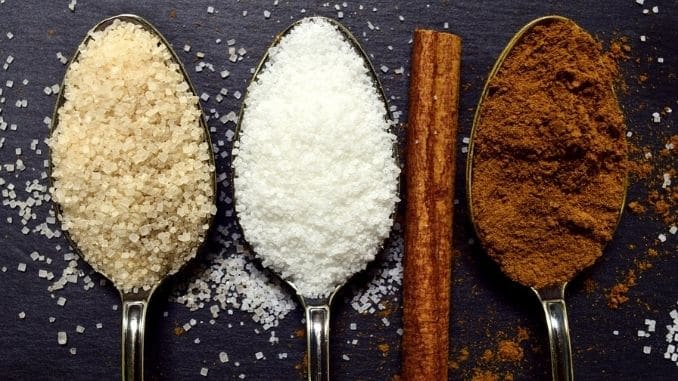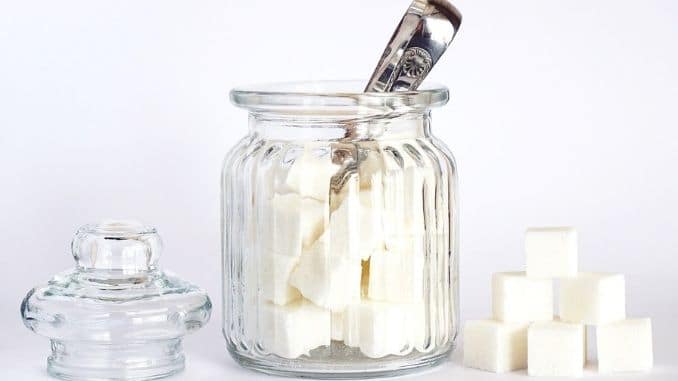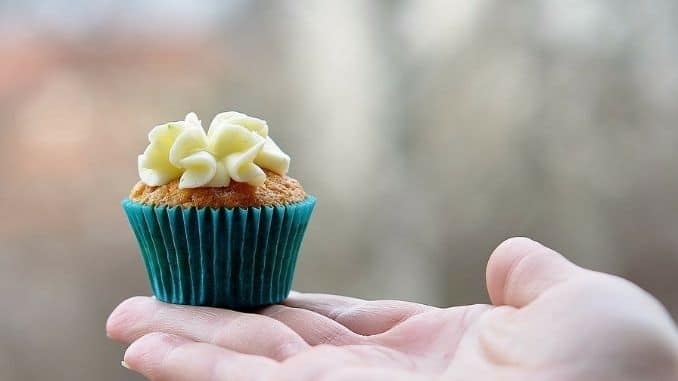
The American Heart Association (AHA) recommends that women eat no more than six teaspoons of added sugar per day and men no more than nine teaspoons. Yet research shows that the average American consumes 17 teaspoons every day, which translates into about 57 pounds of added sugar per year.
This isn’t good news as studies show that too much added sugar is associated with several health problems, including obesity, heart disease, type 2 diabetes, depression, and even cancer. Excess sugar has also been linked to accelerated aging, increased fine lines and wrinkles, and low energy.
Cutting back on sugar isn’t easy | 404, however. It’s not only prevalent in sweets and treats, but often hiding in many common foods like cereal, bread, soup, yogurt, condiments, and more.
You don’t have to live your life eating too much sugar all the time, however. We’ve got some tips to help you cut back without feeling like you’re depriving yourself.
How Excess Sugar Affects Health
A little added sugar now and then is unlikely to hurt you. A cookie after dinner, whipped cream on your strawberries or a luxurious piece of dark chocolate isn’t going to send anyone to the hospital.
The problem is that Americans eat way too much sugar | 404. Market research firm Euromonitor looked at data around the world and found people in the United States consume more sugar than people in any other country.
Each American averages 126 grams of sugar per day, which is more than twice the average sugar intake in the other 54 countries observed. Germany ranked a distant second with an average intake of 103 grams per day.
Sugars occur naturally in many foods, including fruits and vegetables, grains and dairy, but it’s the “added” sugars that are connected to ill health. This is the sugar that manufacturers add to foods to increase flavor and extend shelf life.
You’ll find added sugars in all of the following:
- Soft drinks
- Fruit drinks
- Flavored yogurts and yogurt drinks
- Cereals
- Soups
- Bread
- Condiments like ketchup, mustard and salad dressing
- Cured meats
- Jellies and jams
- Nut butter
- Cakes, cookies, pies, rolls, pastries and other desserts
- Ice cream, frozen yogurt, and sherbet
- Energy and granola bars
- Pasta sauces
This list is only a small sample. When you start looking, you’re likely to find it harder to discover foods without added sugar than foods with it.
A Look at the Health Risks Involved
Eating all this sugar can increase your risk of health problems. The following are some of the negative effects.
Weight Gain
Anytime sugars are added to a food, they increase the calories in that food. That makes it much easier to gain weight when eating foods that have added sugars.
There is also some evidence that fructose, in particular — the type of sugar often used in added sugars like high fructose corn syrup — increases the risk of weight gain and insulin resistance, which can lead to type 2 diabetes.
In one 2002 study, for instance, researchers noted that the consumption of fructose increased by 26 percent from 1970 to 1997 and that this increase could be partially responsible for America’s obesity epidemic. They also found that fructose, when compared with glucose — another type of sugar — fructose was more likely to induce insulin resistance and to raise blood sugar and triglyceride levels.
Type 2 Diabetes
Eating sugar won’t necessarily cause you to get type 2 diabetes, but because it can cause weight gain, which is a clear risk factor for type 2 diabetes, it may cause the disease indirectly. Some studies have also suggested that the prevalence of sugar in our daily diets makes diabetes more common.
In a 2016 review, for example, researchers noted that excessive sugar intake leads to fatty liver and decreased insulin sensitivity. As the body becomes less sensitive to insulin, which processes sugar, blood sugar can become consistently high, potentially leading to type 2 diabetes.
A 2013 study observing people in 175 different countries also showed that an increase in sugar availability in foods was associated with increased diabetes prevalence.
Heart Disease
Excess sugar can have a significant impact on your heart health. In a 2014 study, researchers found an association between a high-sugar diet and a greater risk of dying from heart disease. More specifically, those who got 17 to 21 percent of their calories from added sugar had a 38 percent higher risk of dying from cardiovascular disease than those who consumed 8 percent of their calories as added sugar.
Eating a lot of sugar typically increases triglyceride levels. Triglycerides are fats in the blood and, if you have too many, you are at risk of heart disease. Excess sugar may also raise blood pressure and increase chronic inflammation, both of which are factors in heart disease.
Fatty Liver Disease
Too much sugar can damage your liver, much like too much alcohol can. Fructose, in particular, can be toxic to the liver. While other sugars like glucose go directly to the body’s cells, fructose must be processed in the liver, which converts it to fat.
These tiny fat droplets can accumulate in the liver, causing fatty liver disease, which now affects up to one-third of Americans and has become a leading reason for liver transplants.
Cancer
So far, there is no direct link between sugar and cancer risk, but there is an indirect link. Eating a lot of high-sugar foods can cause weight gain, and excess body fat is known to increase the risk of many cancers.
Some animal studies have also found a direct link between consumption of excess sugars and cancers, including breast cancer while some human studies have found a link between sugar intake and colon cancer. Study results are mixed so far on these, and we need more research, but the implications are that we would be safer to cut back on sugar intake.
Kidney Disease
During the last couple of centuries, we’ve seen an interesting parallel between the consumption of added sugars and the increased prevalence of chronic kidney disease (CKD). Studies indicate that too much sugar can lead to kidney damage. Even slightly elevated blood sugar levels can increase the risk of kidney problems.
Aging
Research shows that sugars damage collagen fibers in the skin, making them less likely to repair themselves.
As the sugar from the foods you eat enters the bloodstream, it attaches to proteins that form harmful new molecules called advanced glycation end products (AGEs). The more these AGEs accumulate, the more they damage other proteins, particularly collagen and elastin, which are primarily responsible for keeping skin firm and young-looking.
Once damaged, these proteins become dry and brittle, leading to wrinkling and sagging.
How to Cut Back on Sugar in Your Diet
Considering all these dangers, we’d all be wise to try to cut back on our sugar intake. Does it matter what type of sugar? Although fructose has been identified as potentially being more harmful than other types, most health experts agree that sugar is sugar and acts generally the same in the body.
That means no sugar is any healthier than another. So, when you’re reading labels, understand that any of the following indicates the presence of sugar:
- Anything ending in “ose,” including fructose, dextrose, glucose, sucrose, and maltose
- Saccharides, monosaccharides, and disaccharides
- Brown rice syrup
- Honey
- Agave nectar or syrup
- Barley malt
- Beet sugar
- Brown sugar
- Cane juice solids, cane sugar, and evaporated cane juice
- Caramel
- Coconut sugar
- Corn sweetener, corn syrup, and high fructose corn syrup
- Date sugar
- Fruit juice concentrate
- Invert sugar syrup
- Malt syrup
- Maltodextrin
- Maple syrup
- Sorghum syrup
- Treacle
1. Read Labels
This is by far the best way to cut back on added sugars in your diet. The good news is that the U.S. Food and Drug Administration (FDA) recently required manufacturers to indicate the amount of added sugars on food labels.
In the past, all they had to do was include the total sugars, which could include both naturally occurring and added sugars. Now, they have to differentiate between the two, which can make it easier for you to choose.
A food with milk or fruit in it, for example, is likely to have some natural sugars that are present in the whole food. Because these are combined with other nutrients like fiber and fats, they usually are better for your body than added sugars.
Watch for those sugars the manufacturers add in after the fact, which will be listed on the food facts under “added sugars.” You may be surprised at how many foods contain them!
2. Cut Back on the Sweet Stuff
This one is obvious, but not always easy to do. You may have a sweet tooth, and feel you’re depriving yourself if you have to avoid your favorites, which can cause you to crave them even more.
Start by combining your favorite piece of cake or cookie with some fruit. You are likely to find that fruit satisfies your sweet craving just as much as dessert, so you can begin to cut back on your serving sizes. Try varying the types of fruit you eat. Consider baking an apple, adding some strawberries to plain Greek yogurt or consuming a handful of dates.
Take your time eating and savor the flavor. Give your brain time to register the intake of sugar, which will help you to eat less.
3. Swap Something Else for That Sugary Beverage
If you like sodas and fruit drinks, it’s time to make a change. Try getting used to drinking something else instead of water, sparkling water, tea, coffee or milk. If you hang in there for a couple of weeks, your taste buds will adjust, and you’ll find it easier to avoid these sugar-laden health destroyers.
4. Look for Brands With Less Sugar — Search the Organic Aisle
Shop for healthy brands of those foods you enjoy that tend to have too much-added sugar. Yogurt, for example, is often way too high in sugar. Look for those brands that offer you less or buy the plain and sweeten it yourself with fresh fruit. Do the same for kefir, cereal, bread, soup, and condiments. Look organic options as they often have less sugar than conventional ones do.
5. Drink More Water
Often, when we think we’re hungry or craving a sweet snack, what we are is thirsty. When your cravings hit, try drinking a full glass of water and waiting 5 minutes before you give in. Water can also give you a full feeling, which may discourage you from sweet snacks.
6. Snack Healthier
Often, when you’re going about your day feeling hurried and stressed, it can be difficult to avoid the temptation to eat something sweet.
Stock up on healthy snacks. Make your own mix of nuts, raisins, and dark chocolate chips, for example, or cut up some fruit and vegetables and combine with a hummus dip. Keep some hard-boiled eggs at hand or mix up some low-sugar cereal with dried fruit.
7. Eat a Low-sugar Breakfast
Breakfast cereals are notoriously high in sugar as are other popular breakfast foods like waffles, pancakes, muffins, and jams. You can make a huge difference in your daily diet by eliminating sugar from this meal.
One of the best breakfast alternatives is plain oatmeal garnished with fresh berries, nuts, and raisins. Other options include eggs prepared however you like them, Greek yogurt or some fresh fruit, tomatoes, and eggs with avocados.
For the best foods to lose weight and heal your body, check out The Best Foods that Rapidly Slim & Heal in 7 Days, here!







